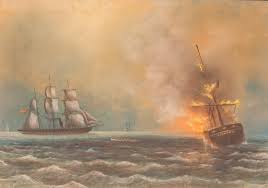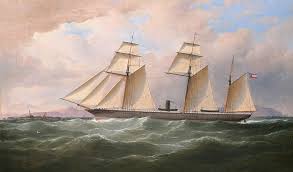
The Confederate Navy was not very large, and the Union ships were numerous and powerful. Nevertheless, the Southern commerce raiders caused significant disruption along the North American coastline. The South’s premier naval captain was Raphael Semmes.
Gone A’ Sailing
He was a sea-faring man. On September 27, 1809, Raphael Semmes was born in Charles County, Maryland. The open water appealed to him, and he was commissioned a midshipman in the United States Navy in 1826. Military life at the time held interesting opportunities. Even though he was in the Navy, Semmes studied law and was admitted to the bar. He practiced law while on leave and wrote a book, Service Afloat and Ashore During the Mexican War (if he was a published poet, we don’t know it.).
He was a ship’s commander during the Mexican War and saw action off the coast of Mexico. Promotions were slow in the antebellum Navy. Semmes was finally promoted to lieutenant in 1837 and made a commander in 1855. He was offered a Confederate naval appointment after Alabama’s secession and resigned from the US Navy on February 15, 1861. He became the most successful commerce raider in the Confederate Navy.
were slow in the antebellum Navy. Semmes was finally promoted to lieutenant in 1837 and made a commander in 1855. He was offered a Confederate naval appointment after Alabama’s secession and resigned from the US Navy on February 15, 1861. He became the most successful commerce raider in the Confederate Navy.
What Were Commerce Raiders?
The South was out-sailed and out-gunned by the North. Therefore, the Confederate strategy on the water was to defend the essential ports and commission ships to attack Northern shipping commerce. Jefferson Davis issued letters of marque that authorized privateers to raid Northern ships and keep the cargoes sold later as prizes. Confederate Navy cruisers were built in Great Britain, where the shipbuilders took care to keep the construction a secret.
 The cruisers were armed with cannons and were often faster than most Union vessels. In addition, the crews were paid and did not rely on prize money. Consequently, Confederates burned many captured ships at sea, and their passengers and crew dropped off in neutral ports. The impact Confederate cruisers and privateers made on the North’s war effort is a topic of much debate, and many historians believe the impact was minimal. Nevertheless, maritime insurance premiums increased dramatically, and Northern merchants were forced to use foreign shipping.
The cruisers were armed with cannons and were often faster than most Union vessels. In addition, the crews were paid and did not rely on prize money. Consequently, Confederates burned many captured ships at sea, and their passengers and crew dropped off in neutral ports. The impact Confederate cruisers and privateers made on the North’s war effort is a topic of much debate, and many historians believe the impact was minimal. Nevertheless, maritime insurance premiums increased dramatically, and Northern merchants were forced to use foreign shipping.
An Effective Buccaneer
Semmes was commissioned a commander in the Confederate Navy in April 1861. He converted a merchant vessel into a commerce raider, christened it the CSS Sumter, and outran the Union blockade of New Orleans in June 1861. Semmes and his crew were in open waters and got to work harassing Northern commerce.
New Orleans in June 1861. Semmes and his crew were in open waters and got to work harassing Northern commerce.
He captured eight merchant vessels near Cuba and added four more prizes as the Sumter sailed to Brazil. Semmes accounted for 18 merchant vessels while commanding the Sumter. Expensive repairs forced him to lay up the Sumter in Gibraltar, but he went from that command to be captain of the ship on which he gained his prominent place in the history of the Confederate Navy.
CSS Alabama
 It started as a British steamer, the Erica, but Semmes reconstructed it into a sloop of war and commissioned it as the CSS Alabama. He commanded this ship from August 1862 until June 1864. The vessel was steam-powered with 2 steam engines and driven by the force of a single screw propeller. The Alabama also had sails. It had a crew of 145 officers and men and was armed with 6-32lb cannon, 1-110lb cannon, and 1-68lb cannon.
It started as a British steamer, the Erica, but Semmes reconstructed it into a sloop of war and commissioned it as the CSS Alabama. He commanded this ship from August 1862 until June 1864. The vessel was steam-powered with 2 steam engines and driven by the force of a single screw propeller. The Alabama also had sails. It had a crew of 145 officers and men and was armed with 6-32lb cannon, 1-110lb cannon, and 1-68lb cannon.
Semmes was enormously successful with his new command. He captured or burned 65 Union ships whose total cargo value was in the millions. The primary hunting ground for this commerce raider was off the coast of Brazil. Semmes was able to capture 29 prizes from February to July 1863. Expeditionary raids of the Alabama included the Gulf of Mexico, South Africa, the Indian Ocean, and the South Pacific. Interestingly, although the Alabama was at sea for 534 days out of 657, she never visited a Confederate port during that time.
The final cruise of the Alabama ended in a classic sea battle in the waters off Cherbourg, France. Semmes confronted the Union sloop of war USS Kearsarge in a maritime dual on June 19, 1864. The engagement went back and forth until one of the shells from the Kearsarge ripped open the midsection of the Alabama starboard water line. Semmes threw his sword into the sea as his ship sank, depriving the Union commander, Capt. John Ancrum Winslow of the traditional surrender ceremony. Semmes and most of his officers were rescued by a private British steamer yacht, the Deerhound. Semmes escaped to England and eventually made his way back to Richmond, Virginia.
England and eventually made his way back to Richmond, Virginia.
Closing Out the War
He was promoted to rear admiral in February 1865, and his final assignment in the war was to be the commander of the James River Squadron. Semmes would eventually surrender his command and receive parole on May 1, 1865. Interestingly, he was commissioned a brigadier general in the Confederate States Army before Lee’s surrender at Appomattox Courthouse. That military commission prevented him from being charged with piracy.
Semmes would be arrested for treason on December 15, 1865. The charges were eventually dropped, and he was released from custody on April 7, 1866. His later life included being a professor of philosophy and literature at what is now the Louisiana State University. He would write his memoirs, and he is credited with coining the phrase War Between the States as a definition of the American Civil War. He would die on August 30, 1877, in Mobile, Alabama.
A Mosquito Strategy
Semmes did have an expeditionary raid off the New England coast (October 3, 1862-November 8, 1862). However, most CSS Alabama voyages carried Semmes hundreds of nautical miles from the American coast. An official objective was to disrupt Northern maritime activity, but was taking prizes and burning ships worthwhile? Northern shipbuilders were able to build two or more ships for every one lost. Moreover, the attacks were taking place far out at sea. The news would not reach the Northern newspapers until weeks or months later.
We suggest a better approach would have been quick strikes all along the northeast coastline.
 The Northern coastline did have extensive fortifications, but not all the forts were in good condition. A raid on a seaport by a coastal raider could destroy docks, warehouses, and ships at anchor. Confederate raiders could seriously disrupt coastal commerce without approaching principal harbors like New York City or Boston. Material damage would perhaps not be substantial, but the impact on civilian morale could have been devastating.
The Northern coastline did have extensive fortifications, but not all the forts were in good condition. A raid on a seaport by a coastal raider could destroy docks, warehouses, and ships at anchor. Confederate raiders could seriously disrupt coastal commerce without approaching principal harbors like New York City or Boston. Material damage would perhaps not be substantial, but the impact on civilian morale could have been devastating.
Daring raids, like mosquitoes, can affect attitudes. Doolittle’s raid on Tokyo and the RAF assault on Berlin during the Battle of Britain made impressions. The civilian populations of Japan and Germany felt vulnerable for the first time. Northern newspapers would have reacted quickly if a Confederate raid had happened just a few miles away. Public outcry might have forced the United States Navy to pull ships away from blockade duty to protect New England seaports.
Those changes in assignment would have taken the pressure off Southern ports and made blockade running more prolific and successful. The Confederate raids would have had enormous propaganda value. The pressure caused by public opinion could have affected Lincoln’s decisions on the conduct of the war, and perhaps led to peace negotiations. Raids intended to harass and destroy commercial ports is an interesting topic, which we leave to professional historians to further explore.
